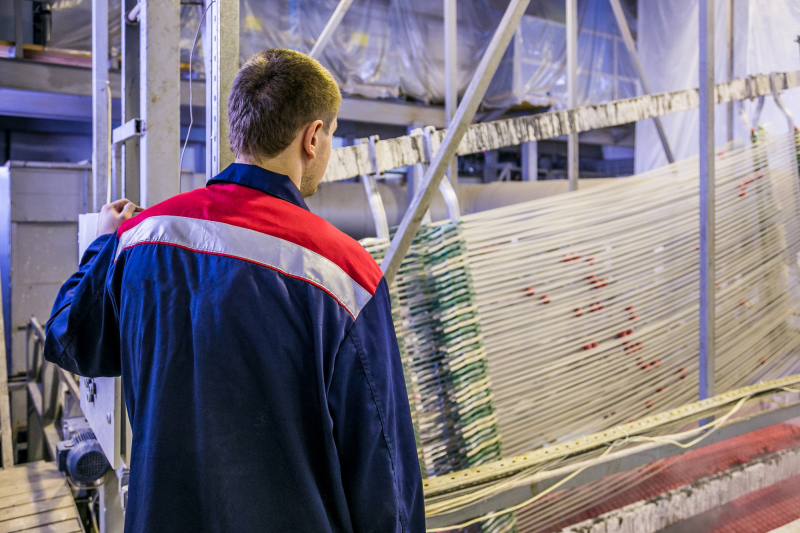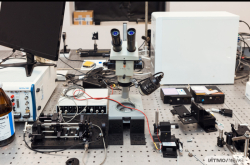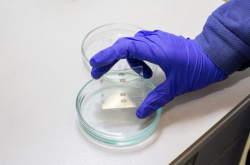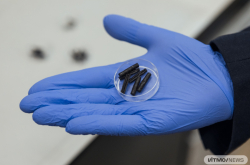Air at production facilities
Hydrogen halides are compounds of hydrogen and halogens, which take the form of colorless gases that are toxic for humans, such as hydrogen chloride (HCl), hydrogen bromide (HBr), and hydrogen iodide (HI). All of these chemical compounds are used in different industries, for instance, for etching metals or in production of soda and detergents.
These compounds are harmful for humans and in high concentrations they may lead to intoxication. That’s why their concentration in the air is regulated by various state standards – and is important to maintain. Even though humans are capable of detecting high concentrations (from 1,000 molecules per a million of air molecules) of such substances via their sense of smell, lower concentrations (less than 10 molecules per a million of air molecules) can only be detected by special gas leak sensors.
Some of the most widely used sensors are electrochemical, but the majority of such devices available on the market demonstrate low sensitivity – they can only detect a specific range of gas concentration. In other words, electrochemical sensors can fail to detect the gas in concentrations outside of their range, as well as have significant errors in their measurements.
Alternatives are optical analyzers based on photon crystals and ring-shaped microresonators. They are more sensitive but harder to produce. Moreover, they are more suitable for detecting biological analytes, because hydrogen halides are used to manufacture them.

A worker etching aluminum parts. Credit: mulderphoto / photogenica.ru
A novel solution
Scientists from ITMO and North Ossetian State University have successfully used perovskite nanolasers to develop a simple and more sensitive photonic sensor to detect hydrogen halides.
Halide perovskite micro- and nanostructures can act like resonators and an optically active environment. Moreover, different geometries of such structures can be produced cheaply using simple solution chemistry methods. That’s why the researchers decided to use an inorganic lead-halide perovskite (CsPbBr3) as a nanolaser in the form of a thread-shaped nanocrystal that is match-like in appearance.
“Perovskites are optically active materials, which means that regularly-shaped perovskite nanostructures serve as resonators and as active environments that can generate laser radiation. In contrast to the broad peak of spontaneous luminescence, laser radiation is spectrally rather thin, which gave us the idea that if this thin line shifts even a tenth of the nanometer, it would help us notice changes in respective external parameters. When we started thinking about where this feature could be applied, we realized that it could be at the core of a highly sensitive gas detector,” explains Daria Markina, the article’s first author and a researcher at the Laboratory of Hybrid Nanophotonics and Optoelectronics.

Researcher working with perovskite nanocrystals at ITMO's School of Physics and Engineering. Credit: ITMO University
The inner workings of leak detection
In their experiments, the researchers aimed to detect hydrogen chloride (HCl). To simulate a leak, the compound’s molecules entered a small isolated cell with a perovskite nanolaser. There, the bromine anions (CsPbBr3) in the thread-shaped crystal engage in an anion exchange reaction with HCl molecules, which results in chlorine anions replacing bromine anions in the perovskite’s crystal lattice. Layer by layer, this reaction forms a new mixed-halide cell (CsPb(Cl,Br)3) that gradually thickens. However, the core of the crystal still contains only bromine anions.
As a result of this mixture of compounds, the luminescence of the nanocrystal’s upper layers will change from green to blue. However, the human eye will only notice this at high concentrations of gas. In order to catch a smaller leak, the researchers use an external femtosecond laser and a spectrometer. The first device helps to optically charge the perovskite nanolaser. The refraction indexes of the outside layer, containing bromine and chlorine, and the bromine-only core are different. The lower refraction index of the outer layer will affect the crystal’s laser generation properties, namely, the spectral location of the laser line. That’s where the spectrometer comes into action to register the spectral location (line length) of the peak of laser generation. These parameters help the researchers detect harmful hydrogen halides in the air and identify their concentration.
Read also:
ITMO Researchers Develop Fast and Simple Perovskite Nanolaser Creation Method
ITMO Scientists Suggest Cheap Way to Control Optical Signals With Halide Perovskites
Paving the Way to Next-Gen Devices: Your Guide to Metaphotonics
The researchers were able to get in-depth on the inner workings of the technology by using X-ray photoelectron spectroscopy (XPS) with ion profiling to demonstrate the formation of the mixed-halide outer layer and its role in the process. XPS is a method based on registering photoelectrons as a result of photoelectric effect, the emission of electrons from solids’ surfaces as a result of their atoms absorbing X-ray radiation. Electron energies in an atom are discrete, not unlike the unique “fingerprints” of each chemical element. This makes XPS one of the most effective methods of analyzing surface composition and stoichiometry. By deleting layer after atomic layer through ion profiling, the researchers were able to prove the formation of a shell-core structure, measure its thickness, and chemical composition.
“This was a challenging experiment, not only because of the special in situ conditions it required, but also due to the related temporal and spatial limitations (the speed of chemical reactions, ion diffusion, natural degradation, and small objects). Thanks to an active collaboration between ITMO and North Ossetian State University, we configured the equipment of the Center for Collective Use “The Physics and Technology of Nanostructures” in the exact way we needed to conduct in situ experiments with XPS and X-ray diffraction. These are unique research methods implemented by the world’s best laboratories,” adds Soslan Khubezhov, a researcher at ITMO’s Faculty of Physics and the head of the Center for Collective Use “The Physics and Technology of Nanostructures” at the North Ossetian State University.

Left to right: a schematic of HCl gas detection based on a perovskite nanolaser encapsulated in a gas cell; a schematic of the resulting shell-core structure; the laser’s typical response to HCl gas – a shift in the laser line towards a shortwave range of the spectrum and a longer interaction time with HCl molecules; a scanning electron microscope image of a typical thread-like perovskite nanocrystal used as a nanolaser. Images courtesy of Daria Markina
A wearable sensor to detect different gasses
At this stage, the technology is capable of detecting leaks of hydrogen chloride, one of the most widely used industrial gases, within minutes. Moreover, the method is effective in a wider range of concentrations, including extra-low ones, down to single particles per a million of air molecules. In the future, the authors can modify the device to enable it to detect other hydrogen halides, as well as increase the sensor’s sensitivity. This will make it possible to detect a mere tenth of a particle in a million of air molecules.
Finally, the researchers don’t exclude the possibility of turning their idea into a compact, portable device that could be used at home or as a wearable at a production site.
“This study is the first step towards demonstrating that halide perovskites can be applied to qualitatively estimate hydrogen chloride concentration. Next, we want to make our sensor optoelectronic by using the perovskite to connect the planar electrodes and close the electric circuit. Having interacted with the crystal, the gas molecules will either increase or decrease the electric current it transmits. This means that gas concentration will influence the electric current directly, making our device even cheaper and more compact,” says Anatoly Pushkarev, a researcher at the Laboratory of Hybrid Nanophotonics and Optoelectronics.
This project received support from the Russian Science Foundation and the Priority 2030 program of the Russian Ministry of Science and Higher Education.
Reference: Daria Markina, Sergey Anoshkin, Mikhail Masharin, Soslan Khubezhov, Ivan Tzibizov, Dmitriy Dolgintsev, Ivan Terterov, Sergey Makarov and Anatoly Pushkarev. Perovskite Nanowire Laser for Hydrogen Chloride Gas Sensing (ACS Nano, 2023).





